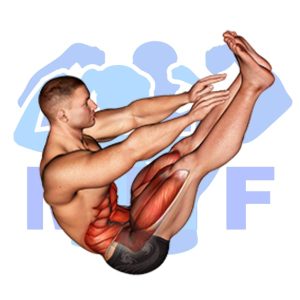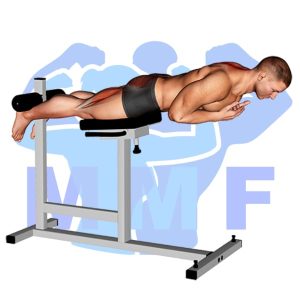If you’re someone who has knee pain and you’re looking to spice up your workouts, then you might be interested in trying knee up exercises with bands. Knee pain is a common issue that people face, especially as they age or if they’re runners or athletes. The pain can be due to factors like overuse, arthritis, or injury. Sympathy aside, it doesn’t mean you should have to suffer through your workouts or completely give up on them altogether. In this blog post, we’ll discuss how to do knee up exercises with bands and why they might be the solution to your knee pain problems.
Knee Up With Bands Summary
- Primary Muscles: Iliopsoas
- Secondary Muscles: Adductor Brevis, Adductor Longus, Pectineus, Sartorius, Tensor Fasciae Latae,
- Equipment: Resistance Band and Ankle Strap
- Mechanics Type: Isolated
- Force: Pull
- Utility: Auxiliary

Knee Up With Bands Instructions
- Begin by setting a band anchor on a low point with an ankle strap connect to your ankle.
- Then while facing away from the anchor point with the band taught bring your leg up to your chest.
- Next, lower your leg back down.
- Repeat these knee ups with one leg for a full set and then switch legs.
Video Tutorial
Knee Up With Bands Muscles
Target (Agonist)
Synergists
Dynamic Stabilizers
- Rectus Femoris
Stabilizers
Antagonist Stabilizers
- None

Benefits of Knee Up With Bands
Knee Up With Bands is an effective exercise for strengthening the iliopsoas muscle, which is a primary hip flexor muscle. This exercise is great for anyone looking to increase their hip mobility and flexibility, as it helps to build strength in the iliopsoas muscle. Additionally, Knee Up With Bands can also help to improve core stability, balance and posture. It is a great way to incorporate strength training into a fitness routine as it can be done anywhere with minimal equipment. The benefits of performing Knee Up With Bands regularly include increased power and endurance, improved range of motion, and decreased risk of injury.
Tips for Performing Knee Up With Bands
Exercising with resistance bands is a great way to get fit and tone your legs and core. Not only do they provide resistance to build muscle, but they also help you work on balance and stability. With the right tips, you can use bands to do knee-ups effectively and get the most out of your workout. Read on for tips on how to do knee-ups with bands for maximum benefit.
- Ensure that the band is tight through out the exercise.
- To increase the resistance step farther away from the anchor point.
- To lower the resistance you can move closer to the anchor point.
Benefits and Tips Video
Frequent Mistakes To Avoid
When you’re working out with bands, it’s important to make sure that you don’t make any mistakes that can affect your progress. Improper form and technique can lead to injury, while using the wrong type of bands can also hinder your progress. That’s why it’s important to know what mistakes to avoid when using bands for knee ups.
- You Don’t Want To go too quickly. Going slower will allow your muscles to be working longer. Whenever you condition with resistance bands, your mission should preferably be to exhaust your muscles so that they can grow stronger. You can do this the most effective through more time under tension.
- Avoid Cheating. In most the time, cheating is employing momentum as a substitute for the force of your agonist (target) muscle tissue. Once in a while, a little bit of cheating on your last rep can be great to overload your muscle, although not for more than a handful of reps.
- Don’t relax your abs. Tightening your core protects your spine by maintaining your internal pressure.
Find More Resistance Band Exercises Here
Variations and Complementary Exercises
To add variety and challenge to your workout, there are several variations, complementary, and alternative exercises for the exercise Knee Up With Bands. These exercises are designed to target the same muscles as the exercise Knee Up With Bands and can be used to increase the intensity of your workout or to give you a new challenge. Below is a list of variations, complementary, and alternative exercises that you can incorporate into your routine.
Lever Lying Leg Raise Bent Knee (Machine)

The Lever Lying Leg Raise Bent Knee (Machine) is an excellent complementary or alternative exercise to Knee Up With Bands. It is a great way to target the same muscles in a different way and challenge them further. This machine helps to target the muscles of the quadriceps and hamstrings and strengthens them. It also helps to increase stability and balance in the lower body, which is essential for the Knee Up With Bands exercise. This exercise can be modified with different levels of resistance and speed, making it suitable for all fitness levels.
Lying Leg Raises With Bands

Lying Leg Raises With Bands is an alternative or complementary exercise to Knee Up With Bands. It targets the lower abs and hip flexors, as well as the upper thighs and glutes. To perform this exercise, you will need a band and a flat surface. Begin by lying on your back with your feet together and the band around your feet. Raise your legs up to a 90-degree angle, hold for a second, then lower them back down. Make sure to keep your core tight throughout the exercise. This exercise will help to strengthen the same muscles used in the Knee Up With Bands exercise, while also providing an additional challenge.
Leg Lift Knee Raise

Leg Lift Knee Raise is an effective and complementary exercise for those who are looking for an alternative to Knee Up With Bands. This exercise requires you to lie on your back and lift your legs off the ground while keeping your knees bent. By holding this position, you engage your core and work your glutes, quads, and hamstrings. Additionally, this exercise can be modified to target different muscle groups and create a more challenging workout. As a result, Leg Lift Knee Raise is an excellent alternative exercise to Knee Up With Bands that helps to strengthen and tone the body.
Check Out These Top Resistance Band Exercises
Knee Hug Crunch

The Knee Hug Crunch is a great alternative or complementary exercise to the Knee Up With Bands. This exercise involves lying on your back and hugging your knees to your chest. You then extend your legs out straight and crunch your upper body, lifting your head and shoulders off the floor. The Knee Hug Crunch works the same muscles as the Knee Up With Bands, but with less resistance. It is a good way to still work the same muscles while providing the joints with a break from the bands. The Knee Hug Crunch also helps to increase core strength, flexibility, and stability.
Jack Knife Sit Up

The Jack Knife Sit Up is an excellent alternative or complementary exercise to the Knee Up With Bands. This exercise targets the abdominal muscles, helping to build core strength. To perform the Jack Knife Sit Up, lie on your back and bring your knees up towards your chest while simultaneously lifting your upper body off the floor. By engaging both the upper and lower body, this exercise provides a comprehensive workout for the core muscles. Furthermore, it helps to increase flexibility and mobility in the hips and lower back.
Incline Leg Hip Raise

The Incline Leg Hip Raise is an effective complementary or alternative exercise to the Knee Up With Bands. This exercise targets the same muscles in the lower body as the Knee Up With Bands, but engages them in a different way. Instead of lifting your knees up, you are lying on an incline bench and lifting your hips up and down. This exercise puts more emphasis on the hip flexors and core muscles while also engaging the glutes, hamstrings, and quads. It’s a great way to target these muscles without putting extra strain on your knees.
Find More Legs Exercises Here
Opposing Complementary Exercises
In order to maximize the effects of the Knee Up With Bands exercise, it’s important to complement it with exercises that work the opposing muscle groups. To do this, you can try the following exercises:
Hyperextension

Hyperextension is a great complementary exercise to Knee Up With Bands because it works the opposing muscle group. It involves lying face down on a flat surface and raising the upper body off the ground using the lower back muscles. The exercise strengthens the lower back muscles, which are important for stabilizing the knee joint when doing Knee Up With Bands. Hyperextension also helps to increase flexibility in the spine, which is important for maintaining proper posture during the exercise. By using both exercises together, you can strengthen both the knee and lower back muscles, providing more stability and power when performing the Knee Up With Bands exercise.
Bench Hyperextension

The bench hyperextension is a great exercise to complement the knee up with bands. It works the opposite muscle group of the knee up with bands by targeting the lower back muscles. This exercise helps to strengthen and stabilize the spine and core, which is essential for any athlete. The bench hyperextension helps to maintain the posture and balance that is required during the knee up with bands. It also provides an additional challenge to the lower back muscles, which can help to improve overall performance and reduce the risk of injury.
Plate Hyperextension

Plate Hyperextension is a great complementary exercise to Knee Up With Bands. It targets the opposing muscle group of the knee up, working on the glutes, hamstrings, and lower back. This exercise is performed by lying face down on a bench with a plate or weight in hand. You then extend your hips and lower back while keeping your chest close to the bench and hold for a few seconds before returning to the starting position. This exercise will help strengthen the muscles in the lower back and glutes, which will help support and stabilize the knee joint while performing the Knee Up With Bands.
Sculpt Stronger Legs With Knee Up Bands!
Looking to sculpt stronger legs? Look no further than knee up bands! These resistance bands are a versatile and easy-to-use tool for targeting your lower body muscles. With a little creativity, you can perform a variety of exercises that challenge your glutes, hamstrings, and quads. Knee up bands are also great for adding intensity to classic exercises like squats and lunges. Plus, they’re small and portable, making them perfect for on-the-go workouts! Incorporate knee up bands into your next leg day and get ready to feel the burn.
References: Wikipedia | ExRx.net | PubMed.gov | Comprehensive List of Legs Resistance Band Exercises




